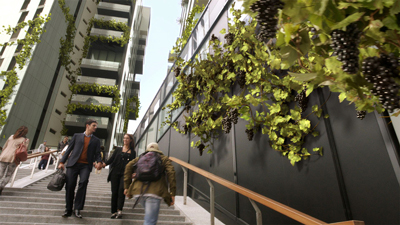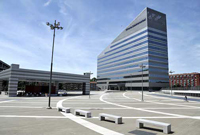You are in: Home page > Magazine Archive > Smart city and new HORIZON

Paola Scala
Smart city and new HORIZON
… beyond (every) “hypocrisy”

Smart-city and star-architecture. Advertising of a famous Italian wine transforming our cities into “vertical – vineyards"
According to the European guidelines of Horizon 2020, the topic “Smart Cities and Communities and Social Innovation” represents a strategic priority for the whole national policy on research and innovation in Italy also, where the national observatory Smart City was established in April 2012. Gianni Dominici, Director of Forum PA, identifies the principal aspects which characterize the “smart city”: the economic aspect supports the presence of innovative research activities capable of attracting economic and professional assets; the human and social aspect - city is “smart” when its own citizens are “smart” - i.e expert and capable of building tolerant and comprehensive relations; finally the third aspect is a “governance” able to promote the dynamic participation of all those involved in the processes and actions modifying the material and immaterial structure of the city. Having overcome the misunderstanding that technology is the aim and not the tool of the process of transforming the city into “smart city”, today architects should once again reflect on their role in this process. But who are the architects that should develop this reflection?
Nobody believes that Architecture is a collection of specialisms but in developing a research project each discipline has to declare its own point of view to better work with the others. Carlo Ratti, promoter of MIT SENSEable City Lab, states that a city is “smart” if it is technological and interconnected, clean and attractive, reassuring and efficient, open and interactive, creative and digital and last but not least “green”. In an interview titled “The green hypocrisy of star-architects” Vittorio Gregotti comments on some reflections developed by Guido Martinotti in his preface to “Green Metropolis”, a David Owen book . As Gregotti writes, more recent research in Architecture arises from misunderstandings about the effects of urban built-up areas on the health environment and from specious interpretations of concepts such as “green”, “smart” and “eco”. Starting with these misunderstandings and false interpretations, architects create fashion slogans and images that do no represent the solution to the serious problems of our age, because it is not possible to automatically deduce a new urban morphology or an architectural form of the city from these problems. Deduction is always an anti-creative methodology. (Gregotti 2011)
Iconic Architecture made up of spectacular images was characteristic of the recent past but if now some people affirm that this phenomenon is over, some others consider it is only in transformation. Sometimes the great contemporary problems -the environmental and economic crises – and the possible answer to them developed by other disciplines – the “smart” and “digital” technologies – become media to create new icons and slogans built in an a-critical way everywhere. Thus, Gregotti warns us about the dangers connected to Architecture using international problems as a “mask” that hides our inability to work efficiently but he also invites us to again reflect on the physical forms of buildings and urban spaces and about their “carattere” interpreted (again) as Architecture’s most precious secret (Quatrmère de Quincy, 1832), able to fix the meaning and identity of the places by means of the form of plan and façade and the balance of mass.
However, today, if architectural research intends finding its own meaning in respect of the physical and immaterial reality, which is also the subject of its own actions, it has to face not only its present contradictions but also its previous mistakes. It is possible to affirm that in the last few years Architecture has worked in an aesthetic field which was completely indifferent to its ethical and social responsibility; it is true as well that recovering this ethic role cannot be an a-critical transfer from other disciplines, but today is also the time to better reflect on the reasons at which the present situation is based. Going beyond the attention-seeking architect and the “fascination” exercised by the new digital “tools” capable of generating unusual and amazing shapes and then of legitimizing them by way of new “parameters” able to assure energy efficiency or economic feasibility, perhaps there are other reasons as the basis of our social disengagement and our escape towards more reassuring certainties. These reasons can also be found in the failure of the ideas on Architecture and City which were our Bible during ’60s and ’70s. Grand utopias built during these years superimposed on the previous urban structure, imposing the assertive rigor of their abstract geometry and the “bigness” not only of the buildings but also of the urban spaces recalling the monumentality of historical public spaces such as the acropolises, agora and squares. These projects had two aims they intended representing the space built for the new “man” and they wanted this space to educate the new man to contemporary living.
Thus, if now it is right to revert Architecture back to its social role and responsibility it is also important that this new social task is aware of the limits and failures of a period when architectural choices were imposed from above, and that it must again start accepting a way of designing arising from below, closer to the people’s needs and more focused on the physical context. Thus, perhaps, “smart city” can represent an area of action for architectural research which is more aware but also more able to accept contemporary challenges.
Smart city is an “extensive” research area where the knowledge of multiple disciplines comes together. Examining the ERC sector list , it is possible to find the word “Architecture” both in the field of “Social Sciences and Humanities” field and in that of “Physical Sciences and Engineering”. Thus, if disciplines such as Urban planning, Technology or Design have clearly identified their own area of work in respect of the main contemporary challenges, those who work on urban and architectural composition struggle to find its own specificity. Information is the raw material of “smart city” which is made up of more aware and well informed citizens. They are more able to play an active role in both in the daily management and in emergency. New Technology is very important for the life of this “2.0 people” but if the passage from the city to the smart-city, from the architectural point of view, means only to replace the skin of buildings with a new “sensitive” one -able to communicate messages, bringing postmodern aesthetics to an excess - or if this passage can be represented only by self regulated buildings able to avoid wastefulness using “domotica”, then there is not much more to add. On the contrary, if this transition regards the transformation of fringe areas in public spaces, their physical forms, their reshaping, their positions and relations, then there are more interesting research opportunities for Architecture.
From this point of view the “typological invention” of Water Squares is very interesting. It was designed by the Dutch group De Urbainsten and was first showed during the Rotterdam Biennale in 2015, dedicated to the relation between water and city and titled was “The Flood”.
The Water Squares are flexible and multitasking spaces, designed for different users. Usually these squares are dry and used as sports and leisure areas. During intense rainfall, water coming from the nearby waterproof areas is collected inside these basins where it remains until the sewage system is able to support a regular steady-outflow. In the Book\ Comic strip ( really smart! ) telling the water- squares experience Florian Boer, founder of the Urbanisten, highlights the “smartness” of a creative and innovative idea which supports the will of the Public Administration to be “open” by giving visibility to the money spent in building this kind of infrastructure. Generally infrastructure constructed for rainwater management are underground tanks and basins hidden for citizens while water squares are public spaces that not only improve environmental quality but also increase the citizens’ civic awareness and their social identity.
These squares do not represent an isolated project but are elements of an overall strategy designed by “Rotterdam Waterplan 2”. This rainwater management plan predicted that by 2035 there would be suffi-cient water squares built in all the urban districts, able to store 580 million litres of extra water.
Initially experiments with a small number of squares were initiated to evaluate the technical effectiveness of this concept and if so it will be implemented in all the urban area. Thus, although this idea was imag-ined as a solution to manage effects of climatic change it also represents a “new urban form” joining various different and complex aspects. These squares create structures spread across the entire urban area, producing new focuses in the suburbs but above all they represent a “smart” public space, that is no longer a “monumental form” evoking ancient archetypes. They are instead a structure where complex relations and uses can be integrated. Paraphrasing Manual Gausa (Gausa 2013) we can say that the “Smart City” theme goes with the transformation of ancient public space, which is representative and homogenous, into the present “spazio relazionale”, more eclectic, more interactive and multifunctional, it also goes with the change in Architecture from an autonomous and\or arbitrary discipline into a conscious research on contemporary landscape and city.
Img 01. Smart-city and star-architecture. Advertising of a famous Italian wine transforming our cities into “vertical – vineyards.
Bibliografia
Boer F. (2010); De Urbanisten and the wondrous water square, Publishers, Rotterdam.
Owen D. (2010); Green metropolis. La città è più ecologica della campagna?, Egea, Milano.
Gausa, M. (2013); “Rinaturalizzare la multi-città” in Ricci M. (2013), Nuovi Paradigmi, LISt, Trento.
Gregotti V. (2011); “le ipocrisie verdi delle archistar”, sul Corriere della sera,18 febbraio.
Koolhaas, R., Boeri S. (2001), Mutation, Actar, New York.
Quatrmère de Quincy A. Ch. (1832), Dictionnaire historique d'architecture, trad. it Teyssot G., Farinati V. (a cura di) (1985), Dizionario storico dell’architettura, Marsilio, Venezia.
Ratti.C. (2013); Smart city, Smart citizen, Egea, Milano.
Sitografia
Di Dominci G. (2012); Smart cities e communities: l'innovazione nasce dal basso http://saperi.forumpa.it/story/65555/smart-cities-e-smart-communities-linnovazione-che-nasce-dal-basso














